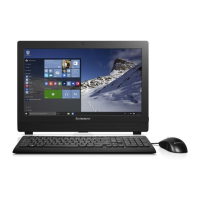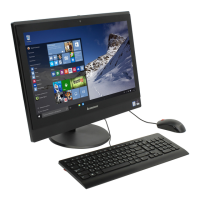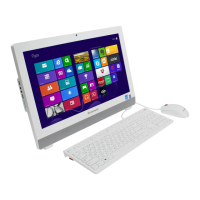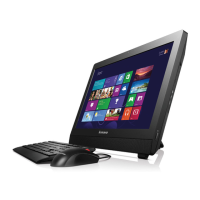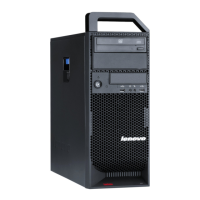Do you have a question about the Lenovo S500z and is the answer not in the manual?
Guidelines for safe use and handling of power cords and adapters to prevent hazards.
Rules to follow for general safety during machine operations and maintenance.
Guide to identify potentially unsafe conditions on products and hazards.
Precautions to prevent damage to components sensitive to electrostatic discharge (ESD).
Details on the physical location of computer hardware components.
Identification of Field Replaceable Units (FRUs) and Customer Replaceable Units (CRUs).
Description of various computer components and their functions.
Lists the physical specifications of the computer, including dimensions, weight, and environment.
Instructions on how to adjust the computer stand for comfortable positioning.
Information and guidelines for using optical discs and the optical drive.
Steps to connect the computer to Ethernet LAN, wireless LAN, and Bluetooth devices.
Explanation of how to use the computer's touch screen capabilities.
Guidance on setting up a comfortable and productive workspace.
Information on features and settings to assist users with disabilities.
Instructions on how to properly clean the computer to maintain performance.
Tips and practices for maintaining the computer for reliable operation.
Methods and devices to secure the computer from unauthorized access.
Procedure for securing the computer using a Kensington-style cable lock.
How to access and modify security settings within the BIOS Setup Utility.
Information on using antivirus software to guard against and eliminate viruses.
Guide to navigating and using the computer's BIOS Setup Utility.
How to enable or disable hardware devices like USB ports in the BIOS.
Instructions on setting, changing, and deleting BIOS passwords for security.
Methods to change the permanent or temporary startup device sequence.
Procedure for updating the system's Basic Input/Output System (BIOS).
A step-by-step process to diagnose and resolve common computer issues.
General guidance and specific solutions for diagnosing and fixing computer problems.
Solutions for issues related to the computer failing to start up correctly.
Troubleshooting steps for no audio or sound issues in Windows.
Solutions for issues related to missing storage drives or OS not found errors.
Troubleshooting common issues related to the computer screen display.
Solutions for issues connecting to Ethernet LAN, wireless LAN, and Bluetooth.
Information on using diagnostic programs to test hardware components.
Precautions for handling components to prevent damage from static electricity.
Guidance on connecting and installing external devices to the computer.
Step-by-step instructions for removing and replacing the power adapter.
Procedures for replacing the computer's stand components.
Instructions on how to safely remove the computer's outer cover.
Detailed steps for replacing the M.2 Wi-Fi card in the computer.
Procedure for safely removing and replacing the computer's heat sink.
Instructions on how to install or replace memory modules.
Step-by-step guide for replacing the computer's main system board.
Instructions for removing and installing the optical drive.
Procedure for replacing the computer's integrated camera.
Final steps to ensure all components are correctly reinstalled after service.
Accessing user guides, help systems, and online resources for computer information.
Information on accessing the Lenovo website for product support and purchases.
Details on the Lenovo Support website for drivers, diagnostics, and manuals.
Guidance on how to contact Lenovo support for warranty service and problem resolution.
Information on additional services available for purchase, such as support and repair.
FCC compliance statement for the digital device regarding radio frequency energy.
Statement of conformity with EU directives on electromagnetic compatibility.
German statement regarding Class B compliance with EU EMC directives.
Information on Waste Electrical and Electronic Equipment (WEEE) regulations and disposal.
Details on collecting and recycling disused Lenovo computers in Japan.
Information on battery recycling according to the European Directive 2006/66/EC.
Compliance with EU Directive 2011/65/EU on hazardous substances in electronics.
Information regarding China's RoHS regulations and substance restrictions.
List of trademarks and service marks related to Lenovo and other companies.
Guidelines for safe use and handling of power cords and adapters to prevent hazards.
Rules to follow for general safety during machine operations and maintenance.
Guide to identify potentially unsafe conditions on products and hazards.
Precautions to prevent damage to components sensitive to electrostatic discharge (ESD).
Details on the physical location of computer hardware components.
Identification of Field Replaceable Units (FRUs) and Customer Replaceable Units (CRUs).
Description of various computer components and their functions.
Lists the physical specifications of the computer, including dimensions, weight, and environment.
Instructions on how to adjust the computer stand for comfortable positioning.
Information and guidelines for using optical discs and the optical drive.
Steps to connect the computer to Ethernet LAN, wireless LAN, and Bluetooth devices.
Explanation of how to use the computer's touch screen capabilities.
Guidance on setting up a comfortable and productive workspace.
Information on features and settings to assist users with disabilities.
Instructions on how to properly clean the computer to maintain performance.
Tips and practices for maintaining the computer for reliable operation.
Methods and devices to secure the computer from unauthorized access.
Procedure for securing the computer using a Kensington-style cable lock.
How to access and modify security settings within the BIOS Setup Utility.
Information on using antivirus software to guard against and eliminate viruses.
Guide to navigating and using the computer's BIOS Setup Utility.
How to enable or disable hardware devices like USB ports in the BIOS.
Instructions on setting, changing, and deleting BIOS passwords for security.
Methods to change the permanent or temporary startup device sequence.
Procedure for updating the system's Basic Input/Output System (BIOS).
A step-by-step process to diagnose and resolve common computer issues.
General guidance and specific solutions for diagnosing and fixing computer problems.
Solutions for issues related to the computer failing to start up correctly.
Troubleshooting steps for no audio or sound issues in Windows.
Solutions for issues related to missing storage drives or OS not found errors.
Troubleshooting common issues related to the computer screen display.
Solutions for issues connecting to Ethernet LAN, wireless LAN, and Bluetooth.
Information on using diagnostic programs to test hardware components.
Precautions for handling components to prevent damage from static electricity.
Guidance on connecting and installing external devices to the computer.
Step-by-step instructions for removing and replacing the power adapter.
Procedures for replacing the computer's stand components.
Instructions on how to safely remove the computer's outer cover.
Detailed steps for replacing the M.2 Wi-Fi card in the computer.
Procedure for safely removing and replacing the computer's heat sink.
Instructions on how to install or replace memory modules.
Step-by-step guide for replacing the computer's main system board.
Instructions for removing and installing the optical drive.
Procedure for replacing the computer's integrated camera.
Final steps to ensure all components are correctly reinstalled after service.
Accessing user guides, help systems, and online resources for computer information.
Information on accessing the Lenovo website for product support and purchases.
Details on the Lenovo Support website for drivers, diagnostics, and manuals.
Guidance on how to contact Lenovo support for warranty service and problem resolution.
Information on additional services available for purchase, such as support and repair.
FCC compliance statement for the digital device regarding radio frequency energy.
Statement of conformity with EU directives on electromagnetic compatibility.
German statement regarding Class B compliance with EU EMC directives.
Information on Waste Electrical and Electronic Equipment (WEEE) regulations and disposal.
Details on collecting and recycling disused Lenovo computers in Japan.
Information on battery recycling according to the European Directive 2006/66/EC.
Compliance with EU Directive 2011/65/EU on hazardous substances in electronics.
Information regarding China's RoHS regulations and substance restrictions.
List of trademarks and service marks related to Lenovo and other companies.
| Screen shape | Flat |
|---|---|
| LED backlight | Yes |
| Display diagonal | 23 \ |
| Display brightness | 250 cd/m² |
| Native aspect ratio | 16:9 |
| Memory slots | 2 |
| Internal memory | 4 GB |
| Memory slots type | SO-DIMM |
| Memory clock speed | 2133 MHz |
| Memory form factor | DIMM/SO-DIMM |
| Internal memory type | DDR4-SDRAM |
| Maximum internal memory | 16 GB |
| Memory layout (slots x size) | 1 x 4 GB |
| HDD size | 2.5 \ |
| HDD speed | 7200 RPM |
| Storage media | HDD |
| Optical drive type | DVD±RW |
| Total storage capacity | 500 GB |
| Compatible memory cards | - |
| Number of storage drives installed | 1 |
| Product color | Black, Silver |
| Camera signal format | 1080p |
| Product type | All-in-One PC |
| RMS rated power | 6 W |
| Antenna type | 1x1 |
| Wi-Fi standards | 802.11a, 802.11b, 802.11g, Wi-Fi 4 (802.11n), Wi-Fi 5 (802.11ac) |
| Bluetooth version | 4.0 |
| Top Wi-Fi standard | Wi-Fi 5 (802.11ac) |
| WLAN controller model | Intel Dual Band Wireless-AC 3165 |
| Ethernet LAN data rates | 10, 100, 1000 Mbit/s |
| Operating system architecture | 64-bit |
| USB 2.0 ports quantity | 3 |
| Thunderbolt ports quantity | 0 |
| Bus type | QPI |
| Stepping | D1 |
| Tjunction | 100 °C |
| Processor code | SR2EY |
| Processor cache | 3 MB |
| Processor model | i5-6200U |
| System bus rate | 4 GT/s |
| Processor family | Intel® Core™ i5 |
| Processor series | Intel Core i5-6200 series |
| Processor socket | LGA 1356 (Socket B2) |
| Processor threads | 4 |
| Processor codename | Skylake |
| Configurable TDP-up | 25 W |
| Processor frequency | 2.3 GHz |
| Processor cache type | Smart Cache |
| Configurable TDP-down | 7.5 W |
| Processor lithography | 14 nm |
| Processor manufacturer | Intel |
| PCI Express slots version | 3.0 |
| Processor boost frequency | 2.8 GHz |
| PCI Express configurations | 1x4, 4x1 |
| Thermal Design Power (TDP) | 15 W |
| Configurable TDP-up frequency | 2.4 GHz |
| Configurable TDP-down frequency | 0.8 GHz |
| Maximum number of PCI Express lanes | 12 |
| Memory types supported by processor | DDR3L-SDRAM, LPDDR3-SDRAM, DDR4-SDRAM |
| Memory channels supported by processor | Dual |
| Memory clock speeds supported by processor | 1866, 2133, 1600 MHz |
| Memory bandwidth supported by processor (max) | 34.1 GB/s |
| Maximum internal memory supported by processor | 32 GB |
| On-board graphics card ID | 1916 |
| Discrete graphics card model | Not available |
| On-board graphics card model | Intel® HD Graphics 520 |
| On-board graphics card family | Intel® HD Graphics |
| Maximum on-board graphics card memory | 1.74 GB |
| On-board graphics card OpenGL version | 4.4 |
| On-board graphics card base frequency | 300 MHz |
| On-board graphics card DirectX version | 12.0 |
| On-board graphics card dynamic frequency (max) | 1000 MHz |
| AC adapter power | 90 W |
| Processor ARK ID | 88193 |
| Processor package size | 42 X 24 mm |
| Supported instruction sets | SSE4.1, SSE4.2, AVX 2.0 |
| Intel Identity Protection Technology version | 1.00 |
| Intel Stable Image Platform Program (SIPP) version | 0.00 |
| Depth (with stand) | 63.7 mm |
|---|---|
| Height (with stand) | 402.4 mm |
| Weight (with stand) | 14800 g |
| Depth (without stand) | 40 mm |
| Width (without stand) | 568.8 mm |
| Height (without stand) | 395 mm |
| Weight (without stand) | 6350 g |

